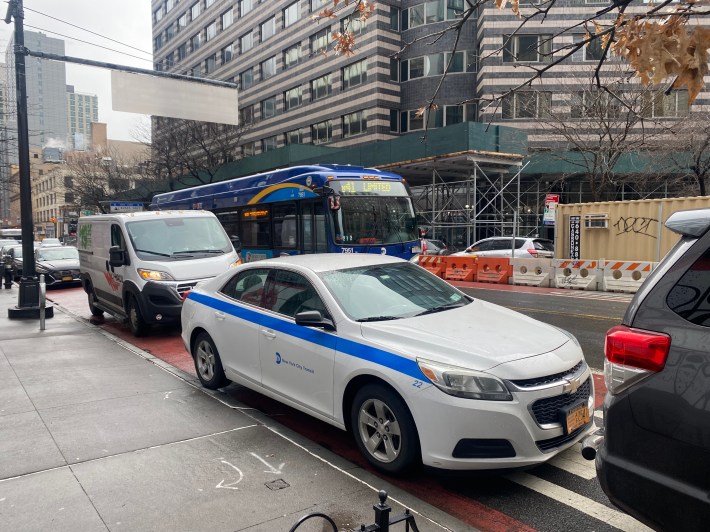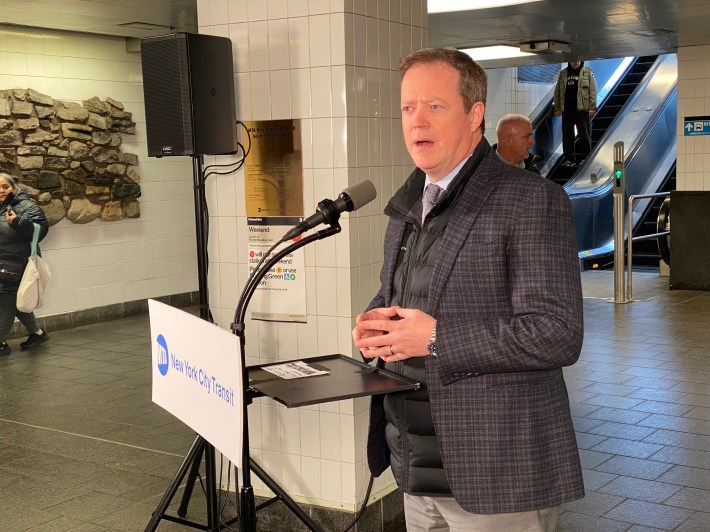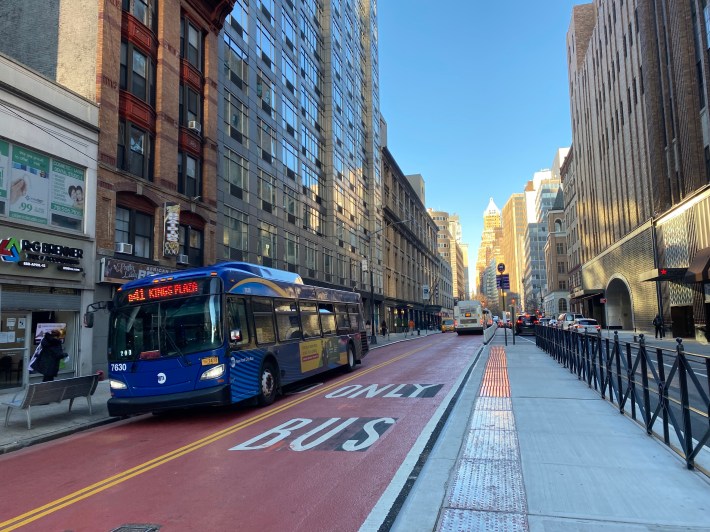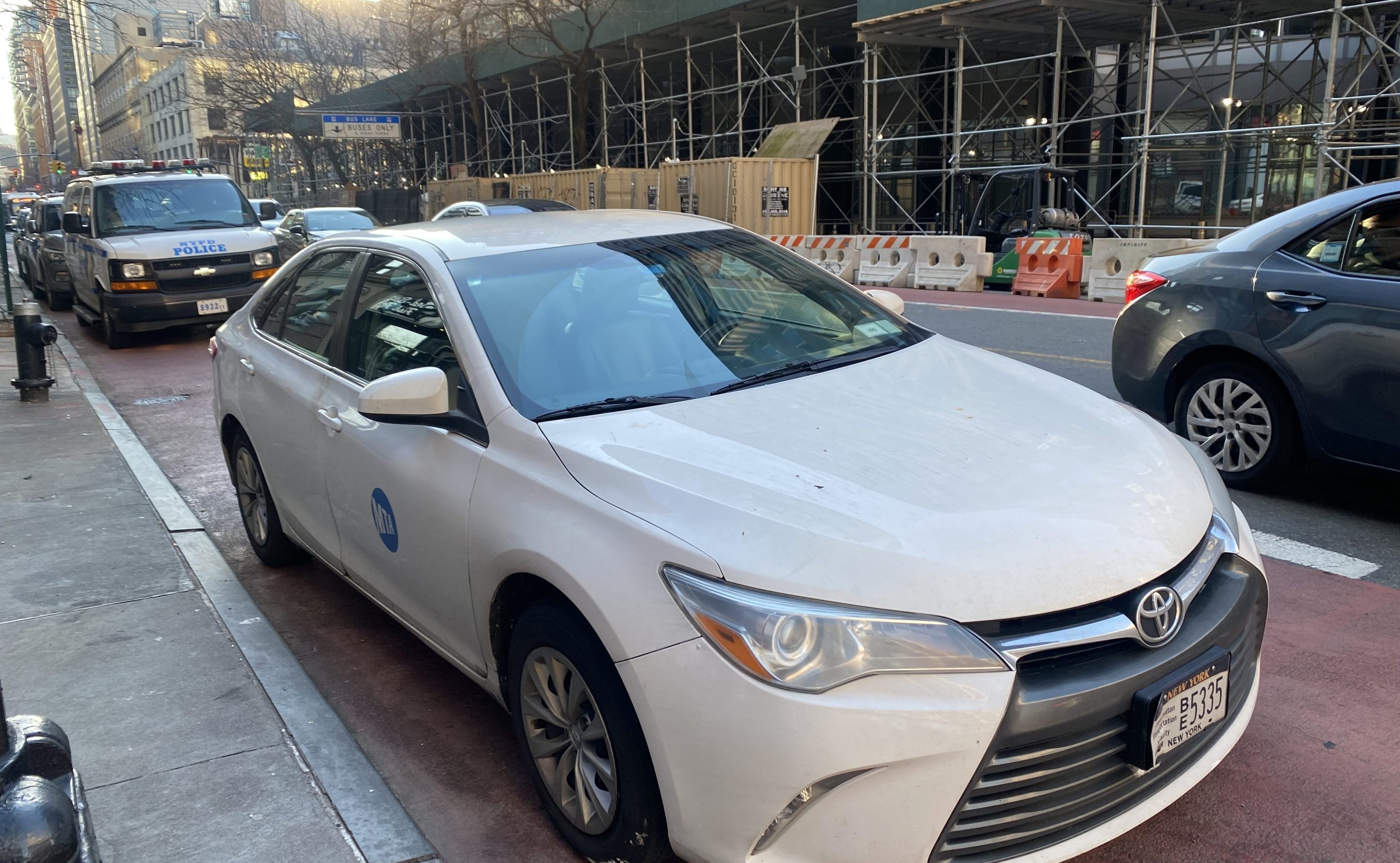The MTA's subway and bus chief vowed to crack down on transit workers who park illegally in the bus lanes outside the agency’s Downtown Brooklyn offices when asked about the persistent problem on the new Livingston Street busway.
“I’ll be out there personally towing and ticketing,” New York City Transit President Richard Davey said on Thursday after Streetsblog asked about the daily presence of cars belonging to the MTA and its workers in the right of way of tens of thousands of bus riders.
“If our employees aren’t getting the message, I’ll have to reinforce it," Davey added. “I’ve had a few sob stories and I’ve said, ‘I’ve been clear: get out of the bus lane.'"
MTA-branded cars, NYPD cruisers and other vehicles marked by various forms of municipal government paraphernalia, including MTA parking placards, blocked the red-painted lanes on Livingston Street on four separate visits over the past two weeks by Streetsblog — including the day after Davey pledged to "personally" address the problem.

Illegal parking was most prevalent outside NYC Transit’s headquarters on Livingston between Smith Street and Boerum Place. The city left that block out of recent bus priority upgrades that included a dedicated busway elsewhere due to construction at the NYCT building set to wrap up in September, an MTA spokesman said.
Excluding the block hurts headways on the busway, according to one advocate who has documented the issue on Twitter under the name NYC Bike Lanes.
"It’s causing the buses to slow down and bunch up and you can’t really get good bus service if the buses bunch up like that," said the person, who requested anonymity due to past NYPD retaliation for reporting illegal parking and placard misuse.
After spending millions of dollars on bus lane enhancements, an @NYCTBus employee has parked in the westbound lane, effectively closing the bus lane & delaying thousands of passengers. pic.twitter.com/tl9okYVyuW
— NYC Bike Lanes (@NYCBikeLanes) January 22, 2024
The stretch and the neighborhood around it have long been a haven for illegal parking by the MTA and other government agencies. Davey previously warned his staff to keep out of the transit paths in November when the new busway was about to open. Cops staged a towing and ticketing spree on the strip days later.
Davey has himself staged well-publicized ticketing blitzes against drivers hogging bus lanes — but the rampant issue has not spared his own backyard.
“Obviously the agency needs to practice what it preaches,” said Danny Pearlstein of the advocacy group Riders Alliance. “If anyone knows the importance of fast and reliable buses, it’s the MTA.”
Employees have to pay for fines themselves, Davey noted. The only two exceptions allowing MTA workers to park in the bus lane are a "bona fide emergency," or if they needed to access a hydrant at 2 or 3 in the morning, he said.
But Streetsblog did not see a single ticket in the windshield of the roughly half-dozen vehicles lining the lanes on its visits to the block. The red-painted curb space is reserved for buses on weekdays from 7 a.m. to 7 p.m.
Vehicles illegally parked outside the transit office had MTA-branded vests, construction helmets, or government-issued placards in their dashboards — a common practice by government officials in the neighborhood.

The MTA could save $268 million a year by speeding up buses by just 15 percent, according to a 2021 report by the nonprofit Citizens Budget Commission.
The city's overhaul of bus lanes on Livingston Street from Smith Street to Flatbush Avenue cut regular traffic to one way to create a separated, two-way busway delineated by concrete boarding islands and plastic dividers for most of the corridor.
Some 50,000 daily riders use the buses that travel on the busway, where buses traveled a 5 mph on average before the new lane configuration launched in the fall, according to MTA data.
On Streetsblog's visits, the now-upgraded sections between Flatbush Avenue and Hoyt Street were cleared of parked cars — allowing buses to easily pass through what used to be a very congested road. Streetsblog readers voted the project "the biggest win" for the livable streets movement in 2023.

DOT may extend the busway all the way to Boerum Place once New York City Transit finishes up construction on the currently busway-less block, officials explained when they unveiled the proposal last May.
“We’re kind of looking at a second phase to this project once the construction wraps up and we would likely start that second phase looking at Hoyt west to Boerum,” DOT transportation planner Tyler Peter told Community Board 2 at the time.






